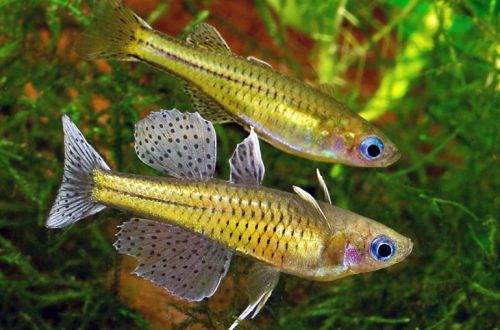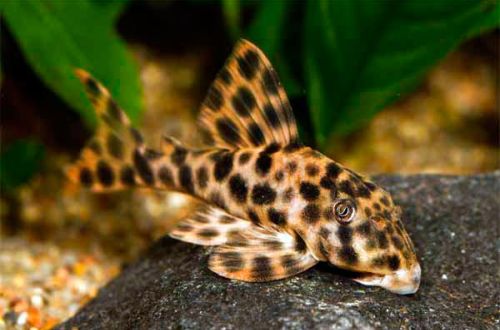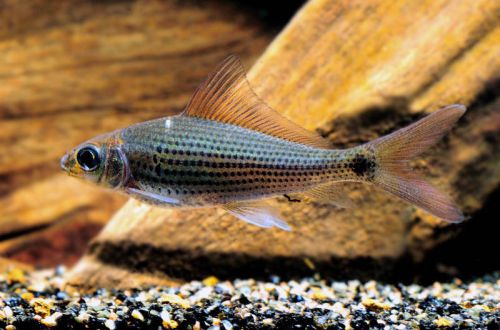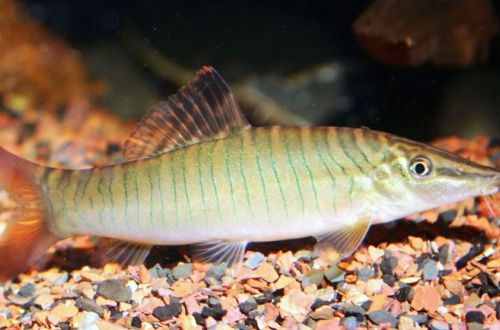
pom xiav-qhov muag
Pseudomugil Gertrude or Spotted blue-eye, scientific name Pseudomugil gertrudae, belongs to the Pseudomugilidae family. The fish is named after the wife of the German naturalist Dr. Hugo Merton, who discovered this species in 1907 while exploring eastern Indonesia. Unpretentious and easy to maintain, due to its size it can be used in nano aquariums.

txheem
Chaw Nyob
Occurs from the northern part of Australia and the southern tip of New Guinea, also found in the numerous islands between them, located in the Arafura and Timor Seas. They live in small shallow rivers with a slow current, swamps and lakes. They prefer regions with dense aquatic vegetation and numerous snags. Due to the abundance of organic matter, the water is usually colored brownish.
Cov ntaub ntawv luv luv:
- Qhov ntim ntawm thoob dej yug ntses - los ntawm 40 litres.
- Kub - 21-28 ° C
- Tus nqi pH - 4.5-7.5
- Dej hardness - mos (5-12 dGH)
- Substrate hom - ib yam
- Teeb pom kev zoo - subdued / nruab nrab
- Cov dej tsis huv - tsis muaj
- Dej txav - me me los yog tsis muaj
- Qhov loj ntawm cov ntses yog mus txog 4 cm.
- Khoom noj - txhua yam khoom noj ntab, feem ntau yog nqaij
- Temperament - kev thaj yeeb
- Khaws hauv ib pab tsiaj tsawg kawg yog 8-10 tus neeg
Hauj lwm
Adult fish reach a length of about 4 cm. The color is yellow with white translucent fins dotted with black specks. A distinctive feature are blue eyes. A similar feature is reflected in the name of this fish. Sexual dimorphism is weakly expressed. Males are slightly larger and brighter than females.
Khoom noj khoom haus
They accept all types of food of a suitable size – dry, frozen, live. The latter are the most preferred, for example, daphnia, brine shrimp, small bloodworms.
Kev tu thiab tu, kho kom zoo nkauj ntawm lub thoob dej yug ntses
Aquarium sizes for a flock of 8-10 fish start at 40 liters. The design uses dense thickets of plants arranged in groups to preserve free areas for swimming. Additional shelters in the form of snags are welcome. Any soil is selected based on the needs of plants.
The fish does not respond well to bright lighting and excessive water movement, so equipment should be selected based on these features.
Water conditions have slightly acidic pH values with low hardness. To maintain high water quality, it is necessary to update it weekly by 15–20% of the volume, and also install a productive filtration system.
Cwj Pwm thiab Compatibility
Calm peaceful fish. Compatible with species of similar size and temperament. Content in a flock of at least 8-10 individuals of both sexes. Best results are achieved in a species tank where small freshwater shrimp are used as neighbors.
Kev yug me nyuam
Breeding the Spotted blue-eye is quite simple and does not require separate preparations. Spawning can occur at any time during the year. The impetus for the beginning of the mating season is an increase in temperature to the upper allowable values (26–28 ° C).
Cov poj niam nteg lawv cov qe ntawm cov thickets ntawm cov nroj tsuag. Rau cov hom phiaj no, cov tsiaj me me thiab cov kab me me, xws li Java moss, lossis cov nroj tsuag cog qoob loo (xws li cov khoom tsim hauv tsev), yog qhov zoo tshaj plaws. Tus txiv neej tseem ceeb feem ntau fertilizes ob peb clutches los ntawm cov poj niam sib txawv ib zaug. Niam txiv instincts tsis tsim; tam sim ntawd tom qab spawning, ntses tuaj yeem noj lawv cov qe.
Txhawm rau khaws cov xeeb ntxwv yav tom ntej, cov qe fertilized raug xa mus rau lub tank cais nrog cov dej zoo tib yam. Cov kib yuav nyob hauv nws kom txog thaum lawv loj txaus (feem ntau txog rau lub hlis). Lub tank cais no yog nruab nrog cov khoom siv tib yam li cov thoob dej yug ntses loj. Qhov tshwj xeeb yog qhov pom qhov system, qhov no nws tsim nyog siv lub tshuab lim cua yooj yim nrog daim txhuam cev ua cov khoom siv lim. Nws yuav muab kev tu kom txaus thiab tsis txhob cuam tshuam kev nqus ntawm kib.
Lub sij hawm incubation kav li ntawm 10 hnub, nyob ntawm qhov kub thiab txias. Nyob rau hauv thawj hnub ntawm lub neej, micro-feed, xws li ciliates, yuav tsum tau. Ib lub lim tiam tom qab, koj tuaj yeem pab Artemia nauplii.
Ntses kab mob
Cov teeb meem kev noj qab haus huv tsuas yog tshwm sim thaum raug mob lossis thaum khaws cia rau hauv cov xwm txheej tsis zoo, uas ua rau lub cev tsis muaj zog thiab, vim li ntawd, provokes tshwm sim ntawm txhua yam kab mob. Nyob rau hauv cov kev tshwm sim ntawm cov tsos mob tshwm sim, ua ntej ntawm tag nrho cov, nws yog tsim nyog los xyuas cov dej rau ntau tshaj ntawm tej yam taw qhia los yog lub xub ntiag ntawm txaus ntshai concentration ntawm tshuaj lom (nitrites, nitrates, ammonium, thiab lwm yam). Yog tias pom muaj qhov sib txawv, coj tag nrho cov txiaj ntsig rov qab mus rau qhov qub thiab tsuas yog tom qab ntawd pib nrog kev kho mob. Nyeem ntxiv txog cov tsos mob thiab kev kho mob hauv Aquarium Fish Diseases section.





